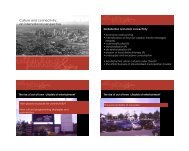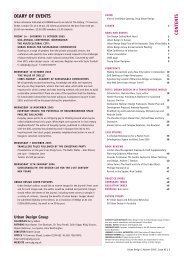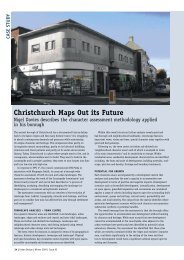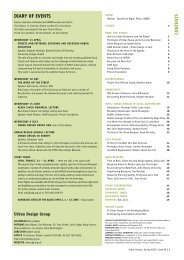URBAN MORPHOLOGY - urban-design-group.org.uk
URBAN MORPHOLOGY - urban-design-group.org.uk
URBAN MORPHOLOGY - urban-design-group.org.uk
You also want an ePaper? Increase the reach of your titles
YUMPU automatically turns print PDFs into web optimized ePapers that Google loves.
All landscapes<br />
have particular<br />
characteristics<br />
that differentiate<br />
them, and which<br />
give them unique<br />
identity and value<br />
are essentially trying to understand and pinpoint how a rural<br />
or <strong>urban</strong> landscape, space, settlement or street has evolved and<br />
what defines its key characteristics and strengths. Both can<br />
provide a baseline of evidence or statement of current character<br />
and condition and both are usually undertaken as a precursor to<br />
developing policies, strategies, action plans or <strong>design</strong> principles<br />
for the future development, conservation or management of an<br />
area or neighbourhood.<br />
Both processes are concerned with the idea of ‘landscape’<br />
as a medium for guiding future action. The ‘holistic’ or broad<br />
landscape idea is one that recognises that different rural and<br />
<strong>urban</strong> landscapes and characteristics exist because of the interrelationship<br />
and interconnection between social, economic<br />
and environmental factors. By looking at this from another<br />
perspective; landscape should be expressed as the common<br />
thread or ‘glue’ that helps to integrate social, economic and<br />
environment needs together, at the same time.<br />
TOPIC<br />
regional countryside character volumes 3 . This approach provides<br />
a systematic way of understanding all landscapes, not just those<br />
<strong>design</strong>ated for their national significance.<br />
The process of characterisation allows landscapes to be<br />
understood, explained, and described in a transparent and<br />
robust way and can aid and inform policies and guidance for<br />
resource, planning, <strong>design</strong> and change management. Landscape<br />
characterisation conveys the multi-faceted and complex intricacy<br />
of landscape that is often hidden within visual appearance.<br />
Characterisation involves assessing the physical components<br />
of landscape alongside socio-economic and cultural influences.<br />
It also works with the way landscapes change over time,<br />
acknowledging the changing influences of people’s activities and<br />
the implications of economic development. The key strength<br />
of landscape character assessment 4 is the way it objectively<br />
disaggregates aspects of landscape that when put together we<br />
describe as overall character.<br />
Landscape characterisation is also a vital foundation in<br />
the visioning, planning and sustainable development of<br />
communities and the landscapes in which they live. Of particular<br />
value is the way it allows for the integration of a wide range<br />
of objectively observed data in holistic statements about all<br />
landscapes: only by having a holistic overview of the character<br />
and function of landscapes can we develop tailored policies and<br />
actions for management and development that accurately reflect<br />
our aspirations and priorities.<br />
A LANDSCAPE CONTINUUM?<br />
Urban morphological analysis and the methodology of landscape<br />
characterisation in many ways share much in common.<br />
Both are concerned with assessing and understanding form,<br />
function, cultural influences and ‘time-depth’ (an appreciation<br />
of the historical influences that has shaped the land or built<br />
environment). Whilst the language used to describe components<br />
and their spatial arrangement may slightly differ, both processes<br />
IMPROVING THE QUALITY OF THE RURAL-<strong>URBAN</strong> FRINGE<br />
Earlier this year the Countryside Agency and Groundwork<br />
launched a consultation vision statement for the rural-<strong>urban</strong><br />
fringe 5 . The crux of the vision is based upon the principle of<br />
achieving landscape multi-functionality and using the existing<br />
statutory planning frameworks to help coordinate, implement<br />
and deliver the vision.<br />
Across the country rural and <strong>urban</strong> local authorities and local<br />
strategic partnerships are busy preparing their local development<br />
frameworks and community strategies. Local development<br />
frameworks, replacing local development plans, are meant to<br />
set out the spatial planning dimension of community strategies.<br />
Community strategies provide the overarching ‘community’<br />
vision for the area – the two need be intrinsically linked, but how?<br />
Whilst most community strategies will include chapters on the<br />
‘green’ environment, very few appear to delve further into visions<br />
and objectives for rural and <strong>urban</strong> landscapes. Perhaps a greater<br />
inclusion of the broad concept of landscape in rural and <strong>urban</strong><br />
areas within community strategies could provide the necessary<br />
spatial ‘hook’ that local development frameworks can draw<br />
inspiration and direction from.<br />
This approach could be particularly effective in the rural<strong>urban</strong><br />
fringe, where landscape character assessment and <strong>urban</strong><br />
morphological analysis can be applied in tandem to help convert<br />
the rather nebulous broad landscape concept into a clearer,<br />
more objective language, understood by communities, and<br />
subsequently used to inform and shape area action plans for<br />
conservation or change. Whilst not groundbreaking in itself,<br />
the process of engaging people and raising awareness of their<br />
rural-<strong>urban</strong> fringe landscapes at the community strategy level<br />
could serve to bring about a wider appreciation of how the<br />
improvement and success of the landscape environment is a<br />
vital component to a better quality of life and to the achievement<br />
of sustainable development.<br />
Andy Wharton, Positive Planning team, Living Landscapes, The Countryside Agency<br />
REFERENCES<br />
1. E Penning-Rowsell and D Lowenthal (eds): Landscape<br />
Meanings and Values. Allen & Unwin, London, 1986<br />
2. Concept statements and Local Development Documents – Practical guidance for<br />
local planning authorities CA149, The Countryside Agency, Cheltenham, 2003<br />
3. Countryside Character Regional Reports, Volumes 1-8,<br />
Countryside Commission, Cheltenham, 1997-1999<br />
4. Landscape Character Assessment: Guidance for England and Scotland,<br />
Countryside Agency/Scottish Natural Heritage, 2002<br />
5. Unlocking the potential of the rural-<strong>urban</strong> fringe, Consultation document,<br />
The Countryside Agency & Groundwork, Cheltenham, 2004<br />
Urban Design | Winter 2005 | Issue 93 | 29







